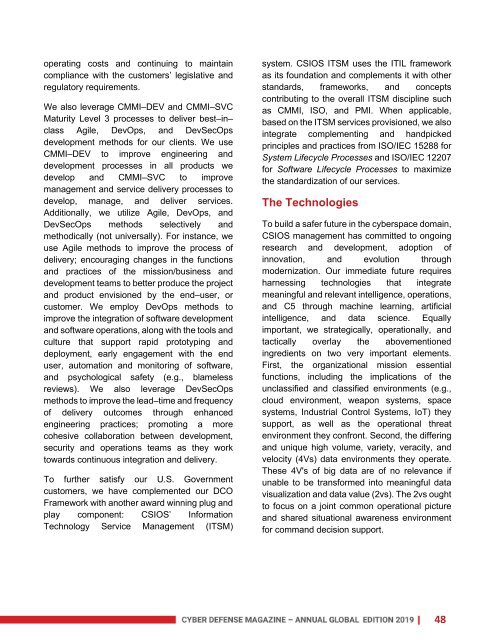Cyber Defense Magazine Global Edition for 2019
Cyber Defense Magazine's Annual Global Edition for 2019: Will Quantum resilient encryption change the future against breaches in our favor? Can deception technology stop the next wave of cybercriminals? This and much more inside this 78 page eMagazine exclusively distributed at www.ipexpoeurope.com each year along with our announcement of the Cyber Defense Global Awards winners for 2019; also found at www.cyberdefenseawards.com.
Cyber Defense Magazine's Annual Global Edition for 2019: Will Quantum resilient encryption change the future against breaches in our favor? Can deception technology stop the next wave of cybercriminals? This and much more inside this 78 page eMagazine exclusively distributed at www.ipexpoeurope.com each year along with our announcement of the Cyber Defense Global Awards winners for 2019; also found at www.cyberdefenseawards.com.
You also want an ePaper? Increase the reach of your titles
YUMPU automatically turns print PDFs into web optimized ePapers that Google loves.
operating costs and continuing to maintain<br />
compliance with the customers’ legislative and<br />
regulatory requirements.<br />
We also leverage CMMI–DEV and CMMI–SVC<br />
Maturity Level 3 processes to deliver best–in–<br />
class Agile, DevOps, and DevSecOps<br />
development methods <strong>for</strong> our clients. We use<br />
CMMI–DEV to improve engineering and<br />
development processes in all products we<br />
develop and CMMI–SVC to improve<br />
management and service delivery processes to<br />
develop, manage, and deliver services.<br />
Additionally, we utilize Agile, DevOps, and<br />
DevSecOps methods selectively and<br />
methodically (not universally). For instance, we<br />
use Agile methods to improve the process of<br />
delivery; encouraging changes in the functions<br />
and practices of the mission/business and<br />
development teams to better produce the project<br />
and product envisioned by the end–user, or<br />
customer. We employ DevOps methods to<br />
improve the integration of software development<br />
and software operations, along with the tools and<br />
culture that support rapid prototyping and<br />
deployment, early engagement with the end<br />
user, automation and monitoring of software,<br />
and psychological safety (e.g., blameless<br />
reviews). We also leverage DevSecOps<br />
methods to improve the lead–time and frequency<br />
of delivery outcomes through enhanced<br />
engineering practices; promoting a more<br />
cohesive collaboration between development,<br />
security and operations teams as they work<br />
towards continuous integration and delivery.<br />
To further satisfy our U.S. Government<br />
customers, we have complemented our DCO<br />
Framework with another award winning plug and<br />
play component: CSIOS’ In<strong>for</strong>mation<br />
Technology Service Management (ITSM)<br />
system. CSIOS ITSM uses the ITIL framework<br />
as its foundation and complements it with other<br />
standards, frameworks, and concepts<br />
contributing to the overall ITSM discipline such<br />
as CMMI, ISO, and PMI. When applicable,<br />
based on the ITSM services provisioned, we also<br />
integrate complementing and handpicked<br />
principles and practices from ISO/IEC 15288 <strong>for</strong><br />
System Lifecycle Processes and ISO/IEC 12207<br />
<strong>for</strong> Software Lifecycle Processes to maximize<br />
the standardization of our services.<br />
The Technologies<br />
To build a safer future in the cyberspace domain,<br />
CSIOS management has committed to ongoing<br />
research and development, adoption of<br />
innovation, and evolution through<br />
modernization. Our immediate future requires<br />
harnessing technologies that integrate<br />
meaningful and relevant intelligence, operations,<br />
and C5 through machine learning, artificial<br />
intelligence, and data science. Equally<br />
important, we strategically, operationally, and<br />
tactically overlay the abovementioned<br />
ingredients on two very important elements.<br />
First, the organizational mission essential<br />
functions, including the implications of the<br />
unclassified and classified environments (e.g.,<br />
cloud environment, weapon systems, space<br />
systems, Industrial Control Systems, IoT) they<br />
support, as well as the operational threat<br />
environment they confront. Second, the differing<br />
and unique high volume, variety, veracity, and<br />
velocity (4Vs) data environments they operate.<br />
These 4V's of big data are of no relevance if<br />
unable to be trans<strong>for</strong>med into meaningful data<br />
visualization and data value (2vs). The 2vs ought<br />
to focus on a joint common operational picture<br />
and shared situational awareness environment<br />
<strong>for</strong> command decision support.<br />
48


















